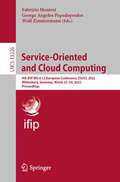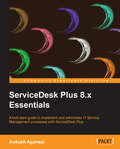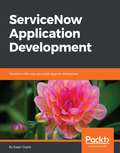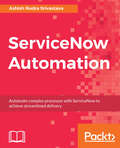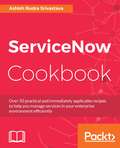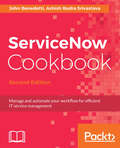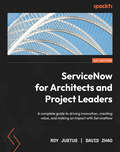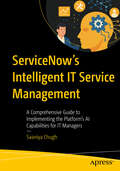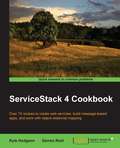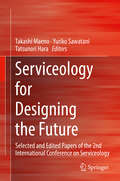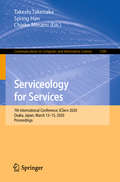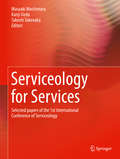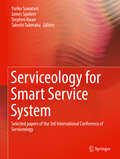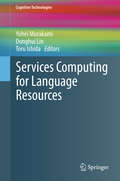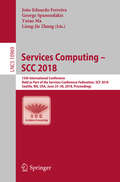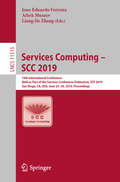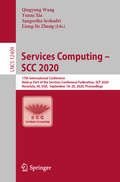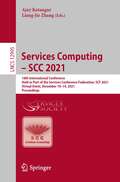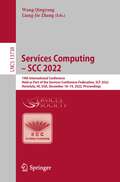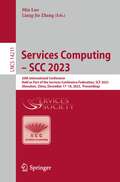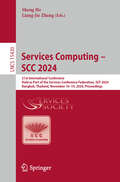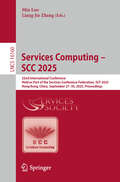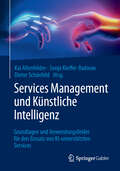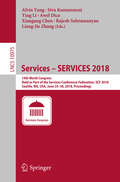- Table View
- List View
Service-Oriented and Cloud Computing: 9th IFIP WG 6.12 European Conference, ESOCC 2022, Wittenberg, Germany, March 22–24, 2022, Proceedings (Lecture Notes in Computer Science #13226)
by George Angelos Papadopoulos Wolf Zimmermann Fabrizio MontesiThis book constitutes the refereed proceedings of the 8th IFIP WG 2.14 European Conference on Service-Oriented and Cloud Computing, ESOCC 2022, held in Wittenberg, Germany, in March 2022. The 6 full and 2 short papers presented in this volume were carefully reviewed and selected from 17 submissions.
ServiceDesk Plus 8.x Essentials
by Ankush AgarwalThis is a practical, hands-on guide that assists you in setting up and efficiently managing ITSM.ServiceDesk Plus 8.x Essentials is for IT helpdesk managers, administrators, and staff, serving as a compendium for service management concepts useful for them.
ServiceNow Application Development
by Sagar GuptaDevelop and extend efficient cloud-native applications with ServiceNow About This Book • Build and customize your apps and workflows to suit your organization's requirements • Perform in-depth application development from designing forms to writing business rules, client-scripts, and workflows • Comprehensive guide to the end-to-end implementation of designing and extending apps with ServiceNow Who This Book Is For If you are a ServiceNow administrator and developer and need to build and customize your service management solution (apps and workflows) with ServiceNow, then this book is for you. What You Will Learn • Customize the ServiceNow dashboard to meet your business requirements • Use Administration and Security Controls to add roles and ensure proper access • Manage tables and columns using data dictionaries • Learn how application scopes are defined within ServiceNow • Configure different types of table to design your application • Start using the different types of scripting options available in ServiceNow • Design and create workflows for task tables • Use debugging techniques available in ServiceNow to easily resolve script-related issues • Run scripts at regular time intervals using the Scheduled Script Execution module In Detail ServiceNow provides service management for every department in the enterprise, including IT, Human Resources, Facilities, Field Service, and more. This book focuses on all the steps required to develop apps and workflows for any of your business requirements using ServiceNow. You will start with the first module, which covers the basics of ServiceNow and how applications are structured; how you can customize the dashboard as required; and also how to create users. After you get used to the dashboard, you will move on to the next module, Applications and Tables, where you will learn about working with different tables and how you can create a scope other than the global scope for your application. The next module is Scripting and APIs, where you will learn Scripting in ServiceNow and use powerful APIs to develop applications. The final module, Administration Essentials, covers debugging, advanced database features, and scheduled script creation. By the end of the book you will have mastered creating organized and customer-friendly applications Style and approach A step-by-step tutorial to designing applications and workflows with ServiceNow
ServiceNow Automation: Automate complex processes with ServiceNow to achieve streamlined delivery
by Poonam Sukhwani Ashish Rudra SrivastavaThe only book you need by your side when automating ServiceNow within your IT organization. Key Features Discover how to automate complex tasks on remote computers quickly and reliably. Learn how to fully utilize the skills and knowledge of your entire organization without increasing costs or labor. Master the skills needed to run orchestration-specific workflow activities with ServiceNow Book Description ServiceNow helps organizations create a modern work environment by making daily activities service-oriented and streamlining the delivery and management of services. Automating these processes and tasks remains at the heart of what ServiceNow does and learning how to automate ServiceNow is critical in putting enterprise-level service management to work. This book shows exactly how IT organizations can automate complex tasks on remote computers quickly and in a secure manner. We will cover various facets of automation and take a multi-system approach with examples ranging from VMware, Amazon EC2, and Active Directory to configuring Puppet and Chef automation. What you will learn Understand the Importance and the power of automation. Replace unstructured work patterns with intelligent workflows. Identify the components of the ServiceNow user interface. Learn to automate and align business service workflows across the organization in support of the core mission. Perform an objective-based analysis that delivers a business case presenting the costs and benefits associated with migrating from legacy solutions to ServiceNowWho this book is for ServiceNow system administrators who would like to automate their processes. Some experience building workflows in ServiceNow is expected. ServiceNow scripting or equivalent knowledge would be helpful.
ServiceNow Cookbook
by Ashish SrivastavaThis book targets IT professionals and administrators who have some experience of working with ServiceNow already and are looking to solve regular or unique problems that surface when using ServiceNow. It’s advisable to have a basic level of administration experience with ServiceNow. Familiarity with JavaScript is assumed.
ServiceNow Cookbook.: Manage and automate your workflow for efficient IT service management
by Ashish Rudra Srivastava John BenedettiOver 60 practical and immediately applicable recipes to help you manage services in your enterprise environment efficiently Key Features One-stop solutions to all the problems encountered while using ServiceNow Covers all the pillars of ServiceNow platform, that is, ITSM, ITOM, and so on Explore new and trending features such as ServiceNow cloud integration and end-to-end security Book Description ServiceNow is the ideal platform from which to create enterprise-level applications, giving both requesters and fulfillers better visibility and access to a process. With this book, we'll guide you through the world of ServiceNow, letting you take on the best the platform offers you with the least amount of hassle. Starting with core configuration and management tasks, this book will help you build data-driven apps and also explores development best practices. You will learn to set up email notifications for users and work with the database view for reporting. Next, you will build/design data-driven apps where you will learn to implement the new Automated Testing framework. You will also be guided through creating various tasks from workflows and how to make the most of workflow utilities available in ServiceNow. Following this, you will learn about Service Portal (new with Helsinki) where you will learn how to configure the portal and how to perform integrations with different cloud platforms, along with tips and tricks on using the portal effectively. Finally, you will learn to use paid plugins such as Discovery, Orchestration, and Service Mapping. By the end of this book, you will have acquired immediately applicable skills to rectify everyday problems encountered on the ServiceNow platform. What you will learn Grasp the basics, such as entering and navigation, required to implement ServiceNow Use ServiceNow plugins to manage development Build and publish custom applications for service management Design data-driven apps to connect with the outside world by getting into client and server scripting Start using the Service Portal to easily create portals for end users Configure alerts and notifications and understand e-mail troubleshooting and watermarking Build and configure reports to set up your dashboard as per requirements Who this book is for If you are an IT professional or an administrator with some experience of working with ServiceNow already and are looking to solve regular or unique problems that surface when using ServiceNow, then this book is for you. It's advisable to have a basic level of administration experience with ServiceNow. Familiarity with JavaScript is assumed.
ServiceNow IT Operations Management
by Ajay GuggillaThe book is aimed at System administrators, IT operations and IT managers who plan to implement ServiceNow IT Operations Management for their organization. They have no knowledge of ServiceNow ITOM.
ServiceNow for Architects and Project Leaders: A complete guide to driving innovation, creating value, and making an impact with ServiceNow
by Roy Justus David ZhaoGain insight and strategic advice for driving value in your organization with this practical guide that condenses a decade of ServiceNow wisdom into the must-know essentials for impactful deploymentsKey FeaturesFocus on what to do when shaping and leading a ServiceNow journeyExplore strategies for making your projects impactful and valuableGuidance for leaders at every level to maximize return on their investments in ServiceNowBook DescriptionServiceNow is the leading enterprise service management platform that enables the effective management of services in a modern enterprise.In this book, you'll learn how to avoid pitfalls that can challenge value realization, where to focus, how to balance tradeoffs, and how to get buy-in for complex decisions. You'll understand the key drivers of value in ServiceNow implementation and how to structure your program for successful delivery. Moving ahead, you'll get practical guidance on the methods and considerations in securely using ServiceNow. You'll also learn how to set up a multi-instance environment including best practices, patterns and alternatives in the use and maintenance of a multi-instance pipeline. Later chapters cover methods and approaches to design processes that deliver optimal ROI. Further, you'll receive tips for designing technical standards, designing for scale, ensuring maintainability, and building a supportable instance. Finally, you'll focus on the innovative possibilities that can be unlocked in a ServiceNow journey which will help you to manage uncertainty and claim the value of being an early adopter.By the end of this book, you'll be prepared to lead or support a ServiceNow implementation with confidence that you're bringing not only a solution but also making an impact in your organization.What you will learnUnderstand the key drivers of value in ServiceNow implementationStructure your ServiceNow programs for successful deliveryDiscover methods and tools for securely using ServiceNowSet up a multi-instance environment with best practices and patternsArchitect and lead the deployment of AI capabilities in ServiceNowBuild innovative experiences using NLU, virtual agents and the Now Experience FrameworkWho this book is forThis book is for architects, consultants and project leaders looking to drive value by applying ServiceNow effectively and efficiently. Platform administration or development experience is useful but not necessary to get the most out of this book. However, some familiarity with the modules and features of ServiceNow is expected.
ServiceNow’s Intelligent IT Service Management: A Comprehensive Guide to Implementing the Platform’s AI Capabilities for IT Managers
by Saaniya ChughThis book explores how ServiceNow&’s AI capabilities are reshaping IT Service Management by enabling smarter, faster, and more efficient service delivery. It provides a practical guide to leveraging features like Predictive Intelligence, Virtual Agents, and Now Assist to elevate traditional ITSM processes. Emphasizing the importance of strategic planning and thoughtful implementation, it equips organizations to drive intelligent automation and achieve a seamless AI-powered transformation. Designed as a practical guide for IT administrators and decision-makers, this book provides actionable strategies and insights—from understanding ServiceNow's AI-driven innovations to implementing a robust ITSM framework. With step-by-step instructions and real-world examples, it equips you with the skills and resources necessary to harness AI's full potential, drive operational excellence, and align your IT services with your organization's strategic goals in the digital era. You Will: Learn how ServiceNow&’s AI capabilities can transform IT Service Management (ITSM) and its key benefits. Study real-world case studies demonstrating AI's impact on IT service delivery. Explore insights to navigate challenges and ensure a seamless AI adoption journey on your ServiceNow platform. Who This Book is for: IT Service Management (ITSM) managers, IT Managers and IT Leaders
ServiceStack 4 Cookbook
by Kyle Hodgson Darren ReidIf you are a .NET developer who is looking for a simpler way to build services, this is the book for you. It will show you how to write fast, maintainable APIs that are a pleasure to use and maintain starting from the database to the client and everything in-between.
Serviceology for Designing the Future: Selected and Edited Papers of the 2nd International Conference on Serviceology
by Yuriko Sawatani Takashi Maeno Tatsunori HaraThis book provides a useful overall guide to the state of the art in theory and practice of services. It can also serve as a reference book for researchers in various fields, including engineering, marketing, economics, and other disciplines. Advanced works presented here were selected from the proceedings of the Second International Conference on Serviceology (ICServ2014), held September 14–16, 2014. This book helps readers to understand serviceology, which tackles with a broad range of services, the globalization of the economy and also enhances the quality of life of local residents.
Serviceology for Services: 7th International Conference, ICServ 2020, Osaka, Japan, March 13–15, 2020, Proceedings (Communications in Computer and Information Science #1189)
by Takeshi Takenaka Spring Han Chieko MinamiThis book constitutes the refereed proceedings of the 7th International Conference on Serviceology for Services, held in Osaka, Japan, in March 2020.The 16 full papers and 3 short papers presented in this volume were carefully reviewed and selected from 58 submissions. The papers are organized around the following topics: hospitality management; service innovation and employee engagement; service marketing and consumer behavior; customer experience and service design; service engineering and implementation.
Serviceology for Services: Selected papers of the 1st International Conference of Serviceology (Communications In Computer And Information Science Ser. #1189)
by Masaaki Mochimaru Kanji Ueda Takeshi TakenakaServices are key activities in the globalization of the economy and also underlie the quality of life of local residents. The advanced work presented in this book was selected from the proceedings of the First International Conference on Serviceology (ICServ2013), held October 16–18, 2013 in Tokyo. This book provides a useful overall guide to the state of the art in theory and practice of services for researchers in various fields, including engineering, marketing, economics, and others. This work also facilitates the scientific systematization of services and promotes technological developments for solutions of industrial issues.
Serviceology for Smart Service System: Selected papers of the 3rd International Conference of Serviceology
by Yuriko Sawatani Takeshi Takenaka James Spohrer Stephen KwanServices are key activities in a globalized economy and they also underlie the quality of life of local residents. The advanced work presented in this book was selected from the proceedings of the Third International Conference on Serviceology (ICServ2015), held July 7–9, 2015, in San Jose, CA, USA. The conference was supported by the Society for Serviceology. The society was established in 2012 in Japan to explore the scientific systematization of services and to promote technological developments for solutions to industrial issues.This book provides a useful general guide to the state of the art in the theory and practice of services. It can also serve as a valuable reference book for researchers in a wide range of fields from engineering to marketing and economics.
Services Computing for Language Resources (Cognitive Technologies Ser.)
by Yohei Murakami Donghui Lin Toru IshidaDescribing the technologies to combine language resources flexibly as web services, this book provides valuable case studies for those who work in services computing, language resources, human–computer interaction (HCI), computer-supported cooperative work (CSCW), and service science. The authors have been operating the Language Grid, which wraps existing language resources as atomic language services and enables users to compose new services by combining them. From architecture level to service composition level, the book explains how to resolve infrastructural and operational difficulties in sharing and combining language resources, including interoperability of language service infrastructures, various types of language service policies, human services, and service failures.The research based on the authors’ operating experiences of handling complicated issues such as intellectual property and interoperability of language resources contributes to exploitation of language resources as a service. On the other hand, both the analysis based on using services and the design of new services can bring significant results. A new style of multilingual communication supported by language services is worthy of analysis in HCI/CSCW, and the design process of language services is the focus of valuable case studies in service science. By using language resources in different ways based on the Language Grid, many activities are highly regarded by diverse communities.This book consists of four parts: (1) two types of language service platforms to interconnect language services across service grids, (2) various language service composition technologies that improve the reusability, efficiency, and accuracy of composite services, (3) research work and activities in creating language resources and services, and (4) various applications and tools for understanding and designing language services that well support intercultural collaboration.
Services Computing – SCC 2018: 15th International Conference, Held as Part of the Services Conference Federation, SCF 2018, Seattle, WA, USA, June 25-30, 2018, Proceedings (Lecture Notes in Computer Science #10969)
by George Spanoudakis Liang-Jie Zhang João Eduardo Ferreira Yutao MaThis book constitutes the proceedings of the International Conference on Services Computing, SCC 2018, as part of SCF 2018, held in Seattle, WA, USA, in June 2018. The 12 papers presented in this volume were carefully reviewed and selected from numerous submissions. The papers cover the science and technology of leveraging computing and information technology to model, create, operate, and manage business services.
Services Computing – SCC 2019: 16th International Conference, Held as Part of the Services Conference Federation, SCF 2019, San Diego, CA, USA, June 25–30, 2019, Proceedings (Lecture Notes in Computer Science #11515)
by Liang-Jie Zhang Joao Eduardo Ferreira Aibek MusaevThis volume constitutes the proceedings of the 16th International Conference on Services Computing 2019, held as Part of SCF 2019 in San Diego, CA, USA in June 2019. The 9 full papers presented in this volume were carefully reviewed and selected from 15 submissions. They cover topics such as: foundations of services computing; scientific workflows; business process integration and management; microservices; modeling of services systems; service security and privacy; SOA service applications; and service lifecycle management.
Services Computing – SCC 2020: 17th International Conference, Held as Part of the Services Conference Federation, SCF 2020, Honolulu, HI, USA, September 18–20, 2020, Proceedings (Lecture Notes in Computer Science #12409)
by Qingyang Wang Liang-Jie Zhang Yunni Xia Sangeetha SeshadriThis volume constitutes the proceedings of the 17th International Conference on Services Computing 2020, held as Part of SCF 2020 in Honolulu, HI, USA in September 2020.. The 8 full papers and 2 short papers presented in this volume were carefully reviewed and selected from 20 submissions. They cover topics such as: foundations of services computing; scientific workflows; business process integration and management; microservices; modeling of services systems; service security and privacy; SOA service applications; and service lifecycle management.
Services Computing – SCC 2021: 18th International Conference, Held as Part of the Services Conference Federation, SCF 2021, Virtual Event, December 10–14, 2021, Proceedings (Lecture Notes in Computer Science #12995)
by Liang-Jie Zhang Ajay KatangurThis volume constitutes the proceedings of the 18th International Conference on Services Computing 2021, held as Part of SCF 2021 in December 2021 as a virtual event due to COVID-19. The 5 full papers and 2 short papers presented in this volume were carefully reviewed and selected from 21 submissions. It covers the science and technology of leveraging computing and information technology to model, create, operate, and manage business services.
Services Computing – SCC 2022: 19th International Conference, Held as Part of the Services Conference Federation, SCF 2022, Honolulu, HI, USA, December 10–14, 2022, Proceedings (Lecture Notes in Computer Science #13738)
by Liang-Jie Zhang Wang QingyangThis volume constitutes the proceedings of the 19th International Conference on Services Computing 2022, SCC 2022, held as part of SCF 2022 during December 10-14, 2022 in Honolulu, USA.The 8 full papers and 1 short paper presented in this volume were carefully reviewed and selected from 15 submissions. It covers the science and technology of leveraging computing and information technology to model, create, operate, and manage business services.
Services Computing – SCC 2023: 20th International Conference, Held as Part of the Services Conference Federation, SCF 2023, Shenzhen, China, December 17–18, 2023, Proceedings (Lecture Notes in Computer Science #14211)
by Liang-Jie Zhang Min LuoThis book constitutes the refereed proceedings of the 20th International Conference on Services Computing, SCC 2023, held in Shenzhen, China, during December 17–18, 2023.The 6 full papers in this book were carefully reviewed and selected from 18 submissions. They are organized in topical sections as follows: business modeling, business consulting, solution creation, service delivery, and software architecture design, development, and deployment.
Services Computing – SCC 2024: 21st International Conference, Held as Part of the Services Conference Federation, SCF 2024, Bangkok, Thailand, November 16-19, 2024, Proceedings (Lecture Notes in Computer Science #15430)
by Liang-Jie Zhang Sheng HeThis book constitutes the refereed proceedings of the 21st International Conference on Services Computing – SCC 2024, Held as Part of the Services Conference Federation, SCF 2024, held in Bangkok, Thailand, during November 16-19, 2024. The 7 full papers in this book were carefully reviewed and selected from 13 submissions. They are organized in topical sections as follows: business modeling, business consulting, solution creation, service delivery, and software architecture design, development, and deployment.
Services Computing – SCC 2025: 22nd International Conference, Held as Part of the Services Conference Federation, SCF 2025, Hong Kong, China, September 27–30, 2025, Proceedings (Lecture Notes in Computer Science #16160)
by Liang-Jie Zhang Min LuoThis book constitutes the refereed proceedings of the 22nd International Conference on Services Computing – SCC 2025, Held as Part of the Services Conference Federation, SCF 2025, held in Hong Kong, China during September 27–30, 2025. The 7 full papers included in this book were carefully reviewed and selected from 11 submissions. The papers focus on the latest fundamental advances in the state of the art and practice of business modeling, business consulting, solution creation, service delivery, and software architecture design, development, and deployment.
Services Management und Künstliche Intelligenz: Grundlagen und Anwendungsfelder für den Einsatz von KI-unterstützten Services
by Kai Altenfelder Dieter Schönfeld Sonja Kieffer-RadwanDas Herausgeberwerk bietet einen Einblick in das Thema Services Management und Künstliche Intelligenz. In den aufeinander aufbauenden Beiträgen beleuchten die Autorinnen und Autoren technische Grundlagen, praktische Anwendungsfelder, strategische und operative Überlegungen sowie Herausforderungen, die mit der Entwicklung von KI-basierten Services in Unternehmen einhergehen. Im Fokus stehen insbesondere die Kundenzentrierung, die unternehmensinterne KI-Readiness, das Wissensmanagement sowie eine kritische Betrachtung des Datenschutzes und ethischer Fragestellungen. Die Lesenden erhalten Impulse und Best-Practices für die erfolgreiche Implementierung von generativer KI im Services Management, um die Servicequalität zu verbessern und die Zufriedenheit der Kunden proaktiv zu steigern.
Services – SERVICES 2018: 14th World Congress, Held as Part of the Services Conference Federation, SCF 2018, Seattle, WA, USA, June 25–30, 2018, Proceedings (Lecture Notes in Computer Science #10975)
by Ying Li Liang-Jie Zhang Alvin Yang Siva Kantamneni Awel Dico Xiangang Chen Rajesh SubramanyanThis book constitutes the refereed proceedings of the 14th World Congress on Services, SERVICES 2018, held as part of the Services Conference Federation, SCF 2018, in Seattle, USA, in June 2018. The 10 full papers and 3 short papers presented were carefully reviewed and selected from 22 submissions. The papers cover topics in the field of software foundations and applications with a focus on novel approaches for engineering requirements, design and architectures, testing, maintenance and evolution, model-driven development, software processes, metrics, quality assurance and new software economics models, search-based software engineering, benefiting day-to-day services sectors and derived through experiences, with appreciation to scale, pragmatism, transparency, compliance and/or dependability.
